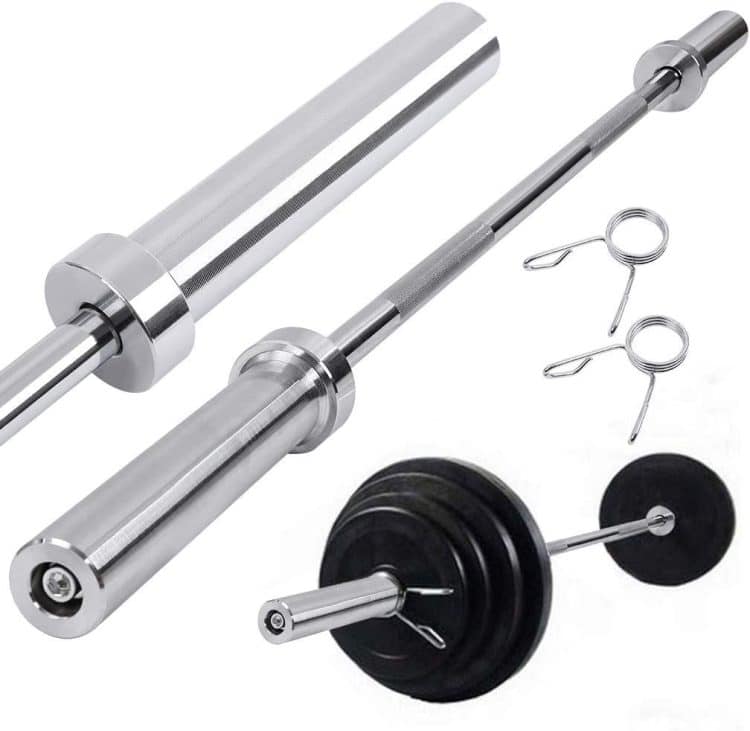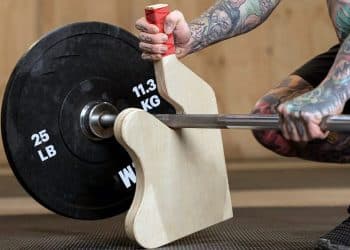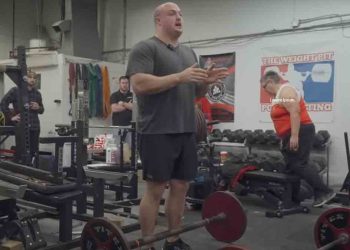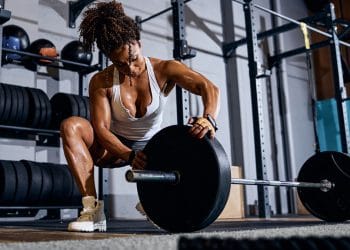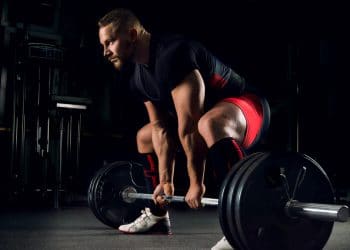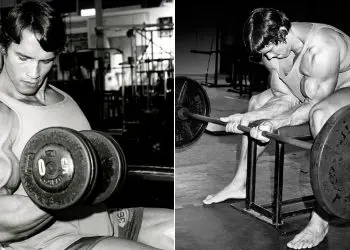The barbell squat is often called the king of exercises, which is probably a title it deserves. After all, squats work your entire lower body and even involve some crucial upper body muscles too. You can use squats to build muscle, develop strength, improve athleticism, and even burn fat.
Squats are so effective that entire workouts have been created around them, such as the old-school 20-rep squat routine.
But, as great as squats are, the deadlift may be superior for many lifters.
Not only do deadlifts work your lower body, emphasizing the all-important posterior chain, but they also involve your upper body far more than squats and actually train far more muscle groups.
The deadlift is virtually a self-contained workout all by itself!
Additionally, all you need to do deadlifts is a bar and a pile of weights; no squat rack is required. And if you get stuck and cannot complete a rep, you can just lower the bar back down to the floor. There is no danger of getting pinned under a heavy weight. That means deadlifts are more accessible than squats and better suited to home, garage, and solo trainers.
Level Up Your Fitness: Join our 💪 strong community in Fitness Volt Newsletter. Get daily inspiration, expert-backed workouts, nutrition tips, the latest in strength sports, and the support you need to reach your goals. Subscribe for free!
In theory, you can deadlift with any kind of bar, even an EZ curl bar or thick bar. However, if you want to maximize your deadlift performance, you may want to start training with a specialist deadlift bar.
In this article, we explain how deadlift bars differ from standard Olympic barbells and why they can help you lift more weight.
Olympic Barbell
Most gyms have standard Olympic barbells. That’s because they are ideal for general use and can be used for a wide range of exercises, including:
Good quality Olympic barbells tend to be made to the same (or very similar) specifications, so, regardless of where you train or which bar you use, they all weigh roughly the same.
The standard specifications for an average Olympic barbell are:
- Length – 86.5 inches
- Thickness – 29 millimeters (1.14 inches)
- Sleeve length – 16-17 inches
- Distance between sleeves – 51.5 inches
- Weight – 20.4 kg (45lbs)
- Tensile strength – 205,000 psi
Olympic barbells tend to be quite stiff, which is a good thing during bench presses and squats. Also, it means you can use an Olympic bar in a squat or power rack without bending it. As such, regular Olympic bars are suitable for rack pulls which could actually damage a more flexible barbell.
This type of bar also tends to have knurling in the center, so the bar is less likely to slip off your back during squats. Knurling is the pattern pressed into the bar that gives it texture and grip.
Some Olympic bars are a little shorter and lighter than the standard specifications. Bars made specifically for women and teenagers are usually 15kg/33lbs and closer to six feet long.
Deadlift Bar

As the name implies, a deadlift bar is made specially for deadlifting. In fact, because of the way it’s made, you should only use a deadlift bar for this purpose. Doing other exercises with one could actually damage it.
While deadlift bars look very similar to standard Olympic barbells, there are some critical differences:
- Length – 90.5 inches
- Thickness – 27 millimeters (1.063 inches)
- Sleeve length – 15.5 inches
- Distance between sleeves – 56 inches
- Weight – 20.4 kg (45lbs)
- Tensile strength – 190,000 psi
So, compared to standard Olympic barbells, deadlift bars:
- Are longer
- Thinner
- Place weights are further apart
- More flexible
They also do not have central knurling, and the knurled handles tend to be more textured for a better grip.
Deadlift Bar Advantages and Benefits
So, how does a deadlift bar help you lift more weight? Good question!
More bar flex and increased whip for better deadlift performance
Because deadlift bars are a little longer and more flexible than Olympic bars, they flex as you start to lift. This means that a deadlift done using a deadlift bar begins a little higher than a regular bar.
This puts you in a biomechanically advantageous position for a stronger pull. As the weights leave the floor, it flexes (called whip) again, which also provides a little extra momentum to your lift.
However, it takes a fair amount of weight to get a deadlift bar to flex, so beginners won’t feel much difference between regular bars and deadlift bars.
Level Up Your Fitness: Join our 💪 strong community in Fitness Volt Newsletter. Get daily inspiration, expert-backed workouts, nutrition tips, the latest in strength sports, and the support you need to reach your goals. Subscribe for free!
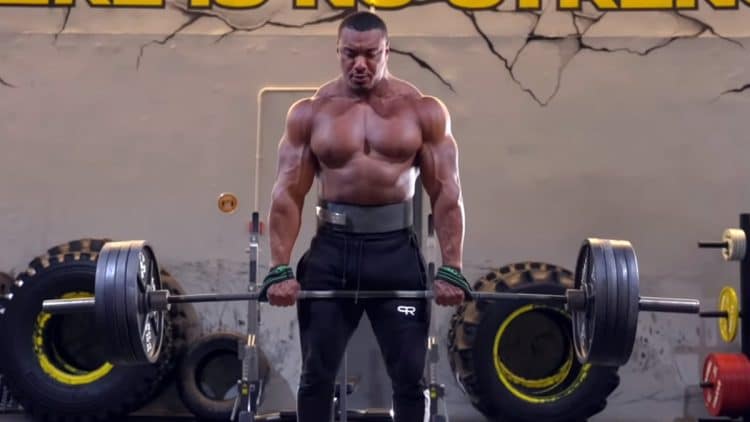
Thinner bars for a better grip
The more you can wrap your fingers around a barbell, the better your grip will be because there will be more friction between your skin and the bar. Deadlift bars are a little thinner than regular barbells, so you should be able to really wrap your hands around them for a more secure grip.
Also, deadlift bars tend to have aggressive knurling, making them even less likely to slip from your fingers. This is crucial in powerlifting because you are not allowed to use lifting straps and must rely entirely on hand strength and chalk to maintain your grip.
No central knurling
If you want to deadlift the heaviest weights possible, you need to keep the bar as close to your legs as you can. Some lifters even drag the bar up their shins to optimize lifting mechanics.
Because standard bars have central knurling, they can rub against your shins, increasing friction and even causing abrasions. But, because deadlift bars have no central knurling, they should slide more smoothly up your legs with less friction. Less friction means more strength for lifting.
Powerlifters wear long socks or calf sleeves to facilitate this while protecting their shins from rubbing.
Deadlift Bar Drawbacks
If you want to deadlift more weight, a specialist deadlift bar may help. But, there are disadvantages to using a deadlift bar, too:
Cost
Deadlift bars tend to be more expensive than multipurpose Olympic barbells. If you can only afford to buy one bar and want to use it for various exercises, you probably shouldn’t buy a pricey deadlift bar. Instead, a regular barbell will be more versatile and budget-friendly.
Ripped-up hands
The deep knurling on a deadlift bar can do a real number on your calluses and can even cause painful skin tears that take weeks to heal. Expect to develop some gnarly calluses if you use a deadlift bar regularly.
Not suitable for other lifts
Deadlift bars are made for deadlifting from the floor – period. Doing other lifts with a deadlift bar could damage it. Given that a good deadlift bar costs upward of $500 or more, compared to under $200 for a standard bar, you don’t want to risk damaging your expensive deadlift bar.
Should not be used in a power rack
Because deadlift bars are made to flex, they should not be used or left in a power rack, especially when loaded with lots of weight. This could cause the bar to become permanently bent and unusable. However, you can use a deadlift bar for block pulls.
Deadlift Bar vs. Stiff Bar Summary
Deadlift bars are designed for deadlifts and are standard equipment for powerlifting competitions. Powerlifting gyms usually have them, but average commercial gyms may not.
They flex more than regular Olympic bars so that, when heavily loaded, you are in a higher, stronger position as the weights leave the floor. They’re also thinner, and the knurling tends to be pretty deep, which makes them easier to grip.
However, deadlift bars are unsuitable for other strength training exercises, and putting them in a squat or power rack can damage them.
Olympic bars are suitable for a wider range of exercises, including deadlifts. Most have got central knurling which makes them especially good for squats.
Because they’re stiffer, Olympic bars are safe for use in squat and power racks. Standard barbells are generally cheaper than deadlift bars and are the type of bar you’ll find in most commercial gyms.
Deadlift Bar Weight – Wrapping Up
Deadlift bars and regular Olympic bars both weigh about the same – 20kg/45lbs. However, deadlift bars tend to be a little longer and thinner than standard barbells. They’re also more flexible, which could improve your deadlift performance, albeit very slightly.
In contrast, regular Olympic barbells are all-purpose bars that you can use for a wide range of strength training exercises, including deadlifts.
But which one should you buy or use?
If money is no object, you have space in your gym for more than one barbell, and you are a competitive powerlifter, a specialist deadlift bar could be useful. Flexible and grippy, deadlift bars can add 3-5% to your deadlift performance.
But, if you want a bar you can use for many different exercises, a general-purpose Olympic bar is the logical choice. And, unless you are very strong, you probably won’t notice much difference between a specialist deadlift bar and a regular barbell. It takes a lot of weight to get much flex from a deadlift bar.
Ultimately, both types of barbells can help build muscle and get stronger, so use the one that best matches your training goals.
So, file deadlift bars under nice to have, but not essential!

